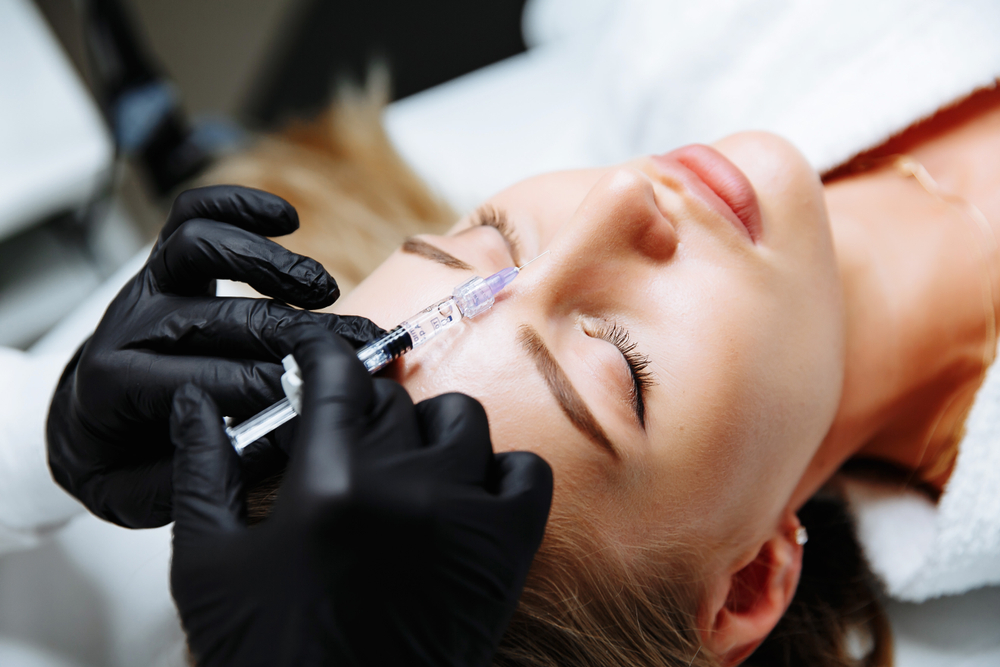Changing the look of your nose transforms your appearance and helps you feel more confident. Whether you’re looking to adjust your nose’s size, shape, or contours, rhinoplasty can do the trick.
Rhinoplasty isn’t a one-size-fits-all procedure, however, so choosing an experienced, board-certified plastic surgeon is essential to getting the best possible results. A skilled surgeon will consider your features as a whole to help you achieve facial balance.
Two of the most popular types of rhinoplasty are surgical rhinoplasty (often referred to as a nose job) and nonsurgical rhinoplasty with dermal fillers (also called liquid rhinoplasty). Each procedure has its advantages and disadvantages.
What Is Surgical Rhinoplasty?
Surgical rhinoplasty reshapes the nose to improve its appearance, function, or both. It can be performed on its own or in combination with other cosmetic surgeries, such as chin augmentation, to improve overall facial symmetry.
People have surgical rhinoplasty to achieve a variety of goals:
- Correcting a crooked or asymmetrical nose
- Reducing a nasal hump
- Reshaping a bulbous tip
- Correcting a long nose
- Narrowing wide nostrils
- Correcting a previously broken nose
- Treating breathing problems caused by a deviated septum or injury to the nose (functional rhinoplasty)
Surgical rhinoplasty typically involves making incisions using either the open or closed technique to remove excess cartilage and skin from the nose, then repositioning and sculpting the remaining tissue. The procedure is performed under general anesthesia and typically takes 1 to 3 hours.
Some patients prefer to plan a couple of weeks of social downtime for the recovery period following surgery. Bruising usually resolves within 10 days, and most swelling subsides within about 2 weeks. After 6 weeks, the swelling is usually significantly reduced. Subtle changes will continue to emerge, and it may take up to a year to see the full results.
Benefits of Surgical Rhinoplasty
Patients may choose surgical rhinoplasty over liquid rhinoplasty because:
- The results are permanent.
- They appreciate the dramatic change the surgery achieves.
- They can improve their overall facial symmetry.
- Their surgeon can correct conditions contributing to breathing problems.
What Is Nonsurgical Rhinoplasty?

Liquid, or nonsurgical, rhinoplasty is a noninvasive procedure that uses dermal fillers—the same injectable treatments used for wrinkles and loss of facial volume—to help you make mild to moderate changes in contour. The procedure temporarily creates a more refined nose without surgery.
Maybe you’re considering rhinoplasty surgery to make permanent changes to your nose but aren’t quite ready to commit. Depending on the corrections you’re seeking, liquid rhinoplasty gives you a preview of the results you can expect before you take the leap.
Dermal fillers add volume, so liquid rhinoplasty isn’t the right choice if you want to reduce the size of your nose. And only a surgical rhinoplasty can repair a broken nose or correct breathing problems.
Nonsurgical rhinoplasty is suitable for making more subtle corrections, including:
- Filling indentations in the nose
- Smoothing out small lumps or bumps
- Straightening a mildly crooked nose
- Lifting a droopy nasal tip
- Plumping the area around the nose
During a liquid rhinoplasty procedure, dermal filler is injected into specific areas of the nose to alter its contours and provide the desired effects. You may experience minor bruising and swelling, but you can resume normal activities immediately after your treatment. Results aren’t permanent, generally lasting about a year. Regular touch-ups will allow you to maintain your results.
Benefits of Liquid Rhinoplasty
Patients may opt for liquid rhinoplasty over surgery because:
- The procedure typically takes less than an hour in the doctor’s office.
- It’s less expensive than surgery in the short term. (You’ll need regular touch-ups to maintain your results.)
- Recovery is easier, and no downtime is required.
- Anesthesia is not needed.
Although liquid rhinoplasty is nonsurgical, it is not without risk. Your nose has many blood vessels that can be damaged during the procedure, so it’s vital you choose a skilled, experienced injector with an excellent safety record.

Which Procedure Is Right for Me?
The main advantage of surgical rhinoplasty over liquid rhinoplasty is that it can provide more dramatic and permanent results. The surgery is customized to meet your specific cosmetic needs, and your surgeon can often correct any issues that may be causing breathing problems.
If you want to make only subtle changes to the contours of your nose, liquid rhinoplasty may be right for you. Still, you should consider whether you’re willing to keep up with the regular touch-ups necessary to maintain your new nose. If you’d rather not, surgery may be your best choice.
Certified by the American Board of Facial Plastic and Reconstructive Surgery and the American Board of Otolaryngology/Head and Neck Surgery, Dr. Keith Ladner is highly experienced in both procedures. At your consultation, he’ll thoroughly assess your features, speak with you about your concerns and goals, and help you determine the best approach for your needs.
To learn more about your rhinoplasty options, call our Denver office at (303) 253-7686 or request a consultation using the online form.


Leave a Reply